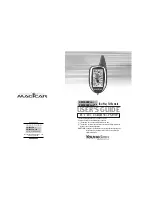
11
le
vel the unit (figs. 7 and 8)
Adjust the hanger nuts so that the unit is inclined 0.5%
towards the condensate drain pan. In the other direction
(air flow direction) the unit must be perfectly level (Fig. 8).
Condensate drain pipe (Fig. 9): Use a flexible pipe with an
inside diameter of 16 mm and provide a constant fall of 20
mm/m over the whole horizontal pipe run. Install a 50 mm
(minimum) siphon to prevent gases and odours from flowing
back into the ceiling void.
If several units are connected to a common collector, a device
must be installed (Fig. 10). Before operating the unit, ensure
that the water flows into the internal condensate drain pan by
pouring some water into it. If problems are detected, check
the drain pipe slope and look for possible obstructions. In
all cases the connection duct(s) at the unit outlet must be
insulated to prevent any condensate formation on the walls.
NOTE: The pressure losses of these ducts must be compa-
tible with the unit performance. The duct must be as smooth
as possible. Avoid sharp bends. Check that there are no
leaks or kinks, and that there is no dirt or installation
debris inside the ducts. Debris within the ducts might
damage the fan wheel and the damper in the air diffusers.
When installation is complete - i.e. when the 42BJ is attached
to the ceiling, air ducts are complete, water manifolds are
in position with stop valves ready on the connection stubs,
and electrical installation is prepared - then connect the
water pipes (Carrier recommends the use of flexible water
pipes that can be supplied as an accessory). Each flexible
pipe has a 1/2" gas screw connector, depending on the
model. Ensure that a gasket (not supplied by Carrier) is
installed between the screw connector and the stop valve.
When all units are installed, open the stop valves on the
manifolds, bleed and then pressurize the circuits. To bleed
the coils, remove the plastic plugs on the coil access door
and then slightly undo the bleed screws with a screwdriver.
Close the valve firmly when all air has escaped.
NOTE: Do not switch on the power until all connections
are made and earthed.
3.3 - Removal procedure
Switch off the unit power supply at the isolator provided
for the purpose during installation (isolator not supplied
by Carrier).
•
Disconnect the power supply and connection cables.
•
Close the isolating valves on the manifolds.
•
Disconnect the flexible water pipes by unscrewing the
gas connectors.
WARNING: Since the flexible water pipes do not have
drain valves, a receiver must be provided to allow the
cooling coil to be drained.
•
Disconnect the supply and return air ducts.
•
Disconnect the flexible condensate drain pipe. Drain
the siphon into a suitable vessel.
•
Support the unit lightly and release it by unscrewing
the four nuts on the threaded hangers. Lower the unit
carefully.
4 - COMPONENTS
4.1 - Fan motor assembly
4.1.1 - description
The ICM has a double inlet high static pressure fan motor
assembly.
The low energy consumption motor uses a 230 V ± 10%,
50 Hz single-phase power supply and runs at variable speed
under the control of a Carrier numeric controller supplying
0-10 V control signal.
4.1.2 - fan motor assembly removal procedure
WARNING: Disconnect the power supply to the unit before
carrying out any work on the unit.
If the fan develops a fault the whole assembly must be
removed and replaced.
•
Remove the fan access panel (12a).
•
Disconnect the fan motor assembly power supply
cables equipped with quick connectors (power and
control wiring).
•
Disconnect the electric heater supply cable from the
42BJ. The cable has three wires terminating in flat
spade connectors.
•
The fan motor and its support are held in place by one
screw (12b) and three lugs. Remove this screw and
slide the assembly free of the lugs.
•
Remove the fan from its support panel (4 screws - 12c).
•
Replace the fan motor assembly and follow the
procedure in reverse order.
WARNING: To reconnect the motor cables separate the
power wiring cable from the control wiring cable and
pull them apart as far as possible.











































